From the guidelines, as from January 2013"People do not need to wait for permission to log your EarthCache. Requiring someone to wait is not supported by the EarthCache guidelines. People should send their logging task answers to you, then log your EarthCache. When you review their logging task answers, if there is a problem, you should contact them to resolve it. If there is no problem, then their log simply stands."

Introduction
The occurrence of dinosaur tracks preserved in limestone is an occurrence that has already been documented in the annals of geocaching and you can check it out here, here and here.
There are many other notable occurrences and “Vale de Meios” is another one of these occurrences but this time with a small twist. This set of tracks are found within an active operating quarry for Portuguese Paving Stones (Calçada Portuguesa) within the Lusitanian Basin.
Geological Setting
In the western end of the Iberian Peninsula most limestones occur mainly from Lisbon to approximately Anadia within what is geologically known as the Lusitanian Basin. This basin occupies approximately 200 km2 and is elongated in an NNW-SSE direction for 200 km and stretches perpendicularly to that for another 100 km. 2/3 of the basin are on the continental landmass and the remainder is submersed in the Atlantic. This sedimentary basin is made up of Cretaceous but mostly Jurassic age limestones that formed during the Mesozoic associated with the opening of the Atlantic Ocean.
The quarry and the tracks
In this quarry the extraction of limestone has exposed strata with clear dinosaur footprints which together with other footprint tracks in the region now integrate an application for a UNESCO World Heritage site.
The Vale de Meios tracks occupy a spectacular area of 11400 m2 where there are hundreds of tridactyl dinosaur footprints arranged mostly in parallel tracks. Because this is a working quarry the number of tracks and area is increasing continually as work progresses in the quarry.
The tracks were made by sauropods and therapods.
|
Therapods
|
Sauropods
|
|
Theropods are a group of bipedal saurischian dinosaurs. Although they were primarily carnivorous, a number of theropod families evolved herbivory during the Cretaceous Period. Theropods first appeared during the Carnian age of the Late Triassic about 230 million years ago and were the sole large terrestrial carnivores from the Early Jurassic until the close of the Cretaceous, about 65 Ma. Today, they are represented by the 9,300 living species of birds, which evolved in the Late Jurassic from small specialized coelurosaurian dinosaurs.
http://en.wikipedia.org/wiki/Theropoda
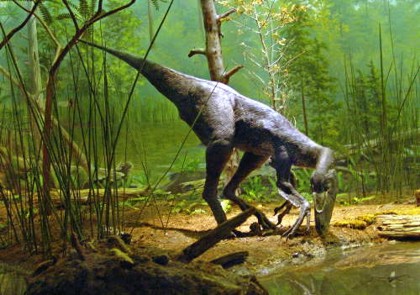
|
Sauropoda, are an infraorder or clade of saurischian ("lizard-hipped") dinosaurs. They are notable for the enormous sizes attained by some species, and the group includes many of the largest animals to have ever lived on land. Well-known genera include Apatosaurus (formerly known as Brontosaurus), Brachiosaurus and Diplodocus. Sauropods first appeared in the late Triassic Period, where they somewhat resembled the closely related (and possibly ancestral) group Prosauropoda. By the Late Jurassic (150 million years ago), sauropods were widespread (especially the diplodocids and brachiosaurids). By the Late Cretaceous, those groups had mainly been replaced by the titanosaurs, which had a near-global distribution. However, as with all other non-avian dinosaurs, the titanosaurs died out in the Cretaceous–Tertiary extinction event. Fossilised remains of sauropods have been found on every continent except Antarctica.
The name Sauropoda was coined by O.C. Marsh in 1878, and is derived from the Greek for "lizard foot".
http://en.wikipedia.org/wiki/Sauropod

|
These footprints are extremely important because they give paleobiological and paleoecological information on the carnivorous dinosaurs of the Middle Jurassic. For example: From the tracks we know that the therapods were moving at an average speed of 4 to 7 km/h and that height from soil to hip was at least 2 m.
If you go to the quarry during working hours, please ask permission to enter the property first!!!!
Note that these records are perishable and they will only last forever with your care. Do not stand in the footprints, don’t scratch at them with your shoe, don’t do anything to damage them.
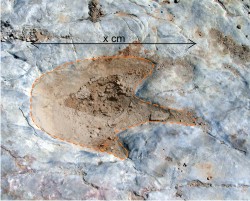 Look, learn and leave for others to enjoy.
Look, learn and leave for others to enjoy.
The EarthCache
In order to claim this EarthCache find go to the coordinates supplied and observe the tridactyl footprints (and take a tape measure with you). Here you need to tell me:
- In which direction were the dinosaurs travelling? (in this particular track).
- What is the distance from the front of the middle toe to the heel of the foot? Precise measurements are needed here.
Send the answers via e-mail to validate your find and don’t place any photos that give away the answers.


Nesta pedreira, a exploração de pedra de calcário colocou a descoberto lajes com pegadas de dinossáurio que constituem o que é hoje conhecida como a “jazida de Vale de Meios” e que integra, conjuntamente com outras jazidas da região (uma delas também numa antiga pedreira) uma candidatura a património da humanidade.
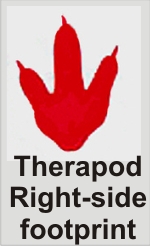 A jazida de Vale de Meios apresenta uma espectacular área de 11400 m2, onde podemos rastrear centenas de impressões tridáctilas de dinossáurios, na grande maioria organizadas em pistas paralelas. O número de pegadas e de pistas, bem como a sua extensão, tem vindo a aumentar à medida que prosseguem quer a extracção de pedra, quer as operações de limpeza da laje e as observações de pormenor ali em curso. Há centenas de trilhos de terópodes de diferentes dimensões. Também pelo menos duas pistas deixadas por grandes saurópodes cruzam uma série de pistas de terópodes de pequena a média dimensão.
A jazida de Vale de Meios apresenta uma espectacular área de 11400 m2, onde podemos rastrear centenas de impressões tridáctilas de dinossáurios, na grande maioria organizadas em pistas paralelas. O número de pegadas e de pistas, bem como a sua extensão, tem vindo a aumentar à medida que prosseguem quer a extracção de pedra, quer as operações de limpeza da laje e as observações de pormenor ali em curso. Há centenas de trilhos de terópodes de diferentes dimensões. Também pelo menos duas pistas deixadas por grandes saurópodes cruzam uma série de pistas de terópodes de pequena a média dimensão.
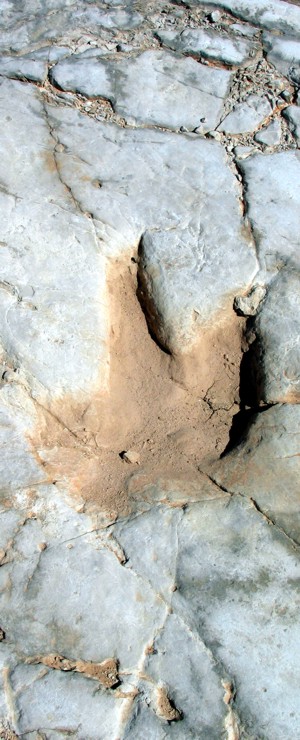 A maior parte das pegadas de terópodes está muito bem conservada e algumas apresentam uma definição de contornos extraordinária. Através do seu estudo é possível obter uma imensa quantidade de informação paleobiológica e paleoecológica sobre os dinossáurios carnívoros do Jurássico Médio, altura em que estes animais ainda estavam numa fase inicial da sua evolução. Podemos conhecer a morfologia dos pés dos animais que as produziram e estudar aspectos da sua locomoção e comportamento.
A maior parte das pegadas de terópodes está muito bem conservada e algumas apresentam uma definição de contornos extraordinária. Através do seu estudo é possível obter uma imensa quantidade de informação paleobiológica e paleoecológica sobre os dinossáurios carnívoros do Jurássico Médio, altura em que estes animais ainda estavam numa fase inicial da sua evolução. Podemos conhecer a morfologia dos pés dos animais que as produziram e estudar aspectos da sua locomoção e comportamento.
As pegadas observadas nestas jazidas foram deixadas por dezenas de terópodes num terreno plano e horizontal, inundado e lamacento, possivelmente junto às margens de uma laguna litoral. Os estudos efectuados indicam que existiram nesta área, no Jurássico Médio, terópodes cujos membros posteriores teriam 2 a 3 m do solo à anca e que estariam a deslocar-se dentro do caminhar, a uma velocidade estimada de 4 a 7 Km/h.
O rasto de um saurópode de grandes dimensões testemunha que também os grandes herbívoros quadrúpedes frequentavam este local.
A jazida de Vale de Meios é um bem do nosso Património Natural de excepcional valor científico, pedagógico e cultural e encontra-se classificada como Imóvel de Interesse Municipal. Actualmente decorre o processo que visa a sua classificação como Monumento Natural, tendo em conta que:
1. é a maior e mais significativa jazida com pegadas de terópodes do Jurássico Médio da Península Ibérica, dada a elevada quantidade de pegadas existentes e o seu excelente estado de conservação;
2. é a única jazida no país onde é possível realizar estudos aprofundados sobre a paleoanatomia, locomoção e comportamento de terópodes;
3. alem de terópodes também revela a existência de saurópodes nesta área durante o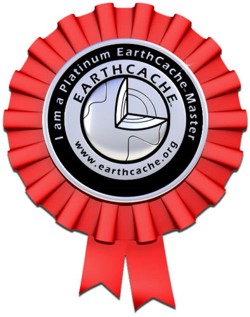 JurássicoMédio.
JurássicoMédio.
Se forem fazer esta cache durante a hora de expediente TÊM DE PEDIR AUTORIZAÇÃO para entrar na Pedreira. As pegadas estão a cerca de 50 m da estrada e no local operam máquinas pesadas.
Vão precisar de uma fita métrica - levem-na convosco.
Para conseguirem um found nesta EarthCache, observem bem as pegadas e digam-me, no local das coordenadas, em que direcção iam os dinos e qual a medida (em cm) da ponta do dedo do meio ao calcanhar de uma das pegadas mais visiveis no local.
Enviem-me as respostas por e-mail para validarem mais um found. Nada de fotos reveladoras nos logs!
Agradece-se à Doutora Vanda Santos do Museu Nacional de História Natural da Universidade de Lisboa a explicação sobre a jazida e a sua importância durante uma deslocação à pedreira em Maio de 2009.
Note: Platinum EarthCache level "ribbon" courtesy of Play mobil.

 The most exciting way to learn about the Earth and its processes is to get into the outdoors and experience it first-hand. Visiting an Earthcache is a great outdoor activity the whole family can enjoy. An Earthcache is a special place that people can visit to learn about a unique geoscience feature or aspect of our Earth. Earthcaches include a set of educational notes and the details about where to find the location (latitude and longitude). Visitors to Earthcaches can see how our planet has been shaped by geological processes, how we manage the resources and how scientists gather evidence to learn about the Earth. To find out more click HERE.
The most exciting way to learn about the Earth and its processes is to get into the outdoors and experience it first-hand. Visiting an Earthcache is a great outdoor activity the whole family can enjoy. An Earthcache is a special place that people can visit to learn about a unique geoscience feature or aspect of our Earth. Earthcaches include a set of educational notes and the details about where to find the location (latitude and longitude). Visitors to Earthcaches can see how our planet has been shaped by geological processes, how we manage the resources and how scientists gather evidence to learn about the Earth. To find out more click HERE.

FTF honours to Sérgio Cruz - Well done!